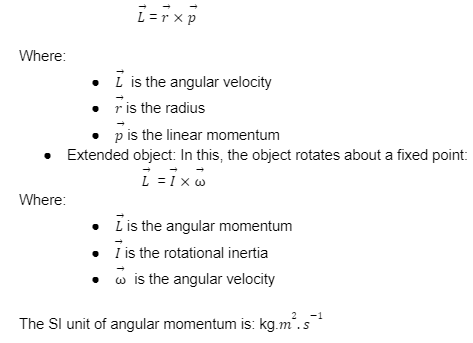When you attempt to hop onto a bicycle and balance it without putting down the kickstand, you might presumably fall off the bicycle. But at the initiation of pedalling the bicycle, the wheels of the bicycle acquire angular momentum.
On the subject of physics, the analogue of rotation of linear momentum is known as the angular momentum of that body. Angular momentum is a significant physical quantity due to it being a conserved quantity, i.e. the total angular momentum calculated for a closed system is always a constant quantity.
Angular momentum possesses both direction and magnitude simultaneously, and both values are preserved. Two-wheelers, disks and ammunition bullets have benefitted from angular momentum for their purposeful functions. Conservation of angular momentum also supports hurricanes having spirals, and neutron stars having extremely high spin values.
Angular Momentum
Angular momentum is a substantial quantity; that is, the cumulative angular momentum of a random complex system is the addition of the angular momenta of all the parts. In the case of either a constant rigid body or a liquid, the cumulative angular momentum is the integral of the three-dimensional domain of angular momentum density on the overall body.
Similar to the conservative laws of linear momentum, on how it is conserved in the absence of an external force, angular momentum is conserved in the absence of external torque. The definition of torque is the rate at which there are changes in the angular momentum of a particular body in comparison to force.
The cumulative external torque on any particular body is equal to the sum of all the torque on the body at all times. In simpler words, the cumulative value of the internal torques of a particular system is always equal to zero (based on the analogue of rotation from Newton’s Third Law of Motion). Thus, for an enclosed system (where there is said to be zero external torque), the value of the cumulative torque on the particular system should be equal to zero. That means that the total angular momentum of the particular system will be constant at all times.
Types of Angular Momentum
We can state two distinct ways of differentiating angular momentum for an object:
- Spring angular momentum, which is the angular momentum about an object’s centre of mass.
- Orbital angular momentum, which can be described as the angular momentum around a given centre.
Our planet represents an orbital angular momentum that is natural due to its revolution around the sun, and it possesses spin angular momentum that is natural due to its rotation about its polar axis. The cumulative angular momentum can be the addition of the spin angular momentum and the orbital angular momentum. Regarding our planet, the primary value that is conserved is the cumulative angular momentum of the solar system due to the angular momentum being replaced by a small, but significant, stretch in between the other planets and the sun.
The orbital angular momentum vector of a particle at a particular point is collateral and proportional directly to its orbital angular velocity vector ω, that is where static proportionality depends on two parameters: the mass of the particle and its distance from its origin. The spin angular momentum vector of a solid body is directly related at all times, but not always in the direction of the spin angular velocity vector Ω, making the static of proportionality a rank two tensor instead of it being a scalar.
Angular Momentum and its SI Unit
There are two conditions when angular momentum is applied to an object:
- Point object: The movement of an object about a fixed point:

Angular Momentum is Important in Astronomy
Many natural weather conditions, such as cyclones, include the conservation of angular momentum to elucidate the dynamics that help these phenomena occur. Winds have revolutions about systems with incredibly low pressures that are mainly caused due to the Coriolis Effect.
If there is an intensification of the low pressure of these systems, and the circulating air is slowly drawn towards the centre of these systems, then the molecules have to increase their speed to have static angular momentum. These speeds become fast enough to become destructive in nature by the time they reach the centre. Johannes Kepler stated the laws of planetary motion without the knowledge of the conservation of momentum.
Even at that time, not long after his statements of laws, their derivations were determined from the conservation of angular momentum. This resulted in realising that cosmic objects move as slow as they are further away while they are on their elliptical orbits. This has been elaborated by the fact that orbital angular momentum is directly in proportion to the radius of that particular planet’s orbit. As there can be no changes seen in the mass of that planet, and the angular momentum is conserved, there is a decrease in the velocity of the planets.
The acceleration of tidal waves is in effect due to the tidal forces that exist between a small satellite that orbits around a bigger planet. The gravitational torque between our natural satellite moon and the tidal bulge of our planet Earth causes the moon to be statically presented to a higher orbit and the Earth to decrease its motion.
Conclusion
On the subject of physics, the analogue of rotation of linear momentum is known as the angular momentum of that body. Angular momentum is a significant physical quantity due to it being a conserved quantity, i.e. the total angular momentum calculated for a closed system is always a constant quantity.
As for angular velocity, we can state two ways to differentiate angular momentum for an object: the spring angular momentum, which is the angular momentum about an object’s centre of mass, and the orbital angular momentum, which can be described as the angular momentum around a given centre.
 Profile
Profile Settings
Settings Refer your friends
Refer your friends Sign out
Sign out




